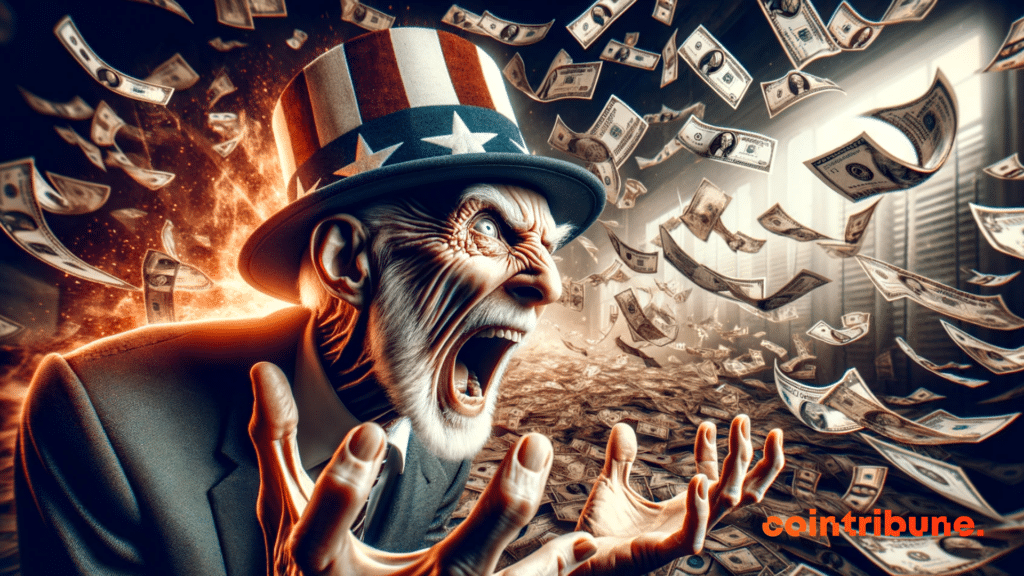This decision will take the markets to new heights
If the Fed were to decide to cut interest rates, we could well witness a meteoric takeoff of the markets. Money would flow freely and certain financial assets like bitcoin (BTC) could reach unprecedented highs.

The Fed Pulled Off a Feat
At this stage, there’s no doubt that the US economy has managed a soft landing.
Even with an incredibly low unemployment rate of 3.7%, job numbers continue to skyrocket: employment surged by more than 350,000 in January, exceeding expectations, and past numbers have been revised upward.
And all this is happening while wages are rising and inflation has returned to the 2% target.
This is a feat. Very few people believed the Fed would be able to curb post-pandemic inflation without throwing a large number of people out of work, but somehow, it has succeeded.
Will the Fed Cut Rates?
The next big question is: will the Fed cut its rates this year?
Great fortunes may hinge on this decision, as well as the short-term fate of the US economy. But the answer is surprisingly unclear. Jerome Powell recently downplayed the likelihood of a cut in March.
Jerome Powell delivered a clear message to traders eager to see the central bank begin lowering interest rates. Powell firmly pushed back against hopes of an early move at the upcoming meeting in March, saying that it is unlikely to act so quickly as it awaits further signs that inflation is steadily approaching its target.
The obvious reason not to reduce rates soon is that the economy is doing so well.
The conventional wisdom is that when everyone has a job and wages are increasing, people buy more products, which ultimately puts upward pressure on prices.
Besides, there’s the general intuition that “if it’s not broken, don’t fix it.” If interest rates of 5.3% haven’t harmed the real economy so far and if they have managed to bring inflation back to its target level, why rock the boat by returning to low interest rates?
That being said, it is likely that the Fed will begin to cut its rates fairly quickly, if not in March, then within the following three months.
Likely Interest Rate Cuts
There are essentially three reasons for this.
First, and most optimistically, we are seeing what appears to be an acceleration of productivity growth.
The simplest measure of short-term productivity growth is labor productivity, i.e., the total economic output per hour worked, adjusted for inflation.
It’s very positive to see labor productivity rising when the economy is booming. These are real improvements thanks to technological applications, better business models…
Rapid productivity growth allows the Fed to cut interest rates.
The reason is fairly simple: productivity growth is an inherently deflationary force. It means that more goods are being produced, which tends to lower prices.
The Fed can counter this trend by cutting interest rates, which puts positive pressure on prices and thus maintains price stability.
In other words, rapid productivity growth represents a positive shock to the overall supply. The Fed needs to ensure that overall demand increases at the same rate as overall supply, to maintain the balance of the economy.
The way to increase the rate of growth of overall demand is to cut interest rates.
Toward a Major Financial Risk?
Reducing inflation without hurting the real economy has been an incredible achievement. But this success could be put at risk if keeping rates high for too long caused a financial crisis and recession.
Many observers believe that the biggest danger to the real economy is the commercial real estate sector. Office buildings are already losing some of their value due to the rise of remote work.
This situation endangers many businesses: developers who build and renovate buildings, leasing companies, businesses that own their office buildings, etc.
High interest rates serve as a double whammy for many of these companies. Real estate firms tend to be highly leveraged – when they have to pay much higher borrowing costs, they tend to go bankrupt.
Many of these companies issued their bonds when rates were low, before 2022, so they’re not at risk right now since they’re still paying those low rates. But the longer rates stay high, the more this debt has to be rolled over at newer, higher rates.
Thus, the longer the Fed maintains high rates, the more real estate firms will go bankrupt.
From a Real Estate Crisis to a Banking Crisis
The real danger is that a wave of defaults from struggling real estate firms harm the banking system, causing damage to the real economy – essentially, a milder version of 2008.
Banks tend to lend a lot to real estate companies, so they are highly exposed. Already, the commercial real estate sector is causing major headaches for some banks.
Regional lenders, in particular, are more exposed to the sector and could be hit harder than their larger banking counterparts. Commercial real estate loans constitute 28.7% of the assets of small banks, compared to only 6.5% for larger lenders.
The longer the Fed keeps rates high, the greater the risk of a financial crisis in which a large number of small and medium-sized American regional banks go bankrupt.
Unlike last year, where the government guaranteed the deposits of medium-sized banks in trouble and thus prevented a crisis, the only way to save small banks in the event of a wave of defaults on commercial properties would be to carry out large-scale bailouts, as in 2009-10.
But even that would probably not be enough to protect the real economy from a recession, as previous experiences have shown.
If this happens, it will end the euphoria caused by the Fed’s successful soft landing. In fact, it will then be a crash landing.
Interest Rates: Brace for the Worst?
Economists will say that disinflations are never without cost – that ultimately, there is always a recession. Experts will wonder if the Fed should have raised its rates in the first place or just waited for inflation to disappear on its own.
But if the Fed cuts its rates before the expiration of most low-interest rate debts related to commercial real estate, businesses will be saved from a refinancing death.
Remote work may still cause some bankruptcies, but the risk of a systemic financial crisis will be significantly reduced.
Markets Predict an Interest Rate Cut
The third big reason why the Fed should cut its rates is because markets and businesses are expecting it to.
Even after Powell’s recent comments, markets expect the Fed to significantly reduce its rates starting from spring:
In fact, markets anticipate that the Fed will begin cutting its rates even faster than its own forecasts predict.
Why should this influence the current policy of the Fed? Because part of the current economic upswing may be due to these expectations of rate cuts by the Fed.
Businesses may have made large investments thinking they could refinance their debt at a lower cost in a year or two.
If these assumptions prove false – if the Fed keeps rates higher than markets foresee – it could lead to the bankruptcy of more businesses and, consequently, a weakening of the real economy.
We might thus turn a soft landing into a crash landing.
Politics and Interest Rates
There are at least two other reasons why the Fed should cut its rates, and both are political in nature.
First, when interest rates stay high for a long time, the federal government has to allocate a much larger portion of its budget to repaying the national debt’s interest.
This is already happening.
To avoid this, the Fed might want to lower interest rates, so the government can refinance the debt at a lower cost.
However, for the time being, the US does not seem to be under threat of default. Therefore, the Fed will probably not use low rates as a way to bail out Congressional overspending.
Creating such a precedent would effectively bind the Fed to Congress’s spending decisions, which would compromise the institution’s independence.
Trump’s Influence on the Federal Reserve
The other political factor is Donald Trump, who appears to have a decent chance of winning in November. Trump has repeatedly threatened the independence of the Federal Reserve.
The Fed is very, very committed to its independence. Hence, some (including Trump himself) have suggested that the Fed might soon cut rates to keep the economy healthy and maximize President Biden’s re-election chances.
The risk of a “prolonged rate hike” is that it could lead to a deterioration of the economy as elections approach and jeopardize Biden’s chances.
Should that happen, “former President Trump is the most likely to be elected president and will have the opportunity to reshape the Fed truly in his image this time around, which could damage the institution’s credibility more than Powell would have by lowering rates during the presidential campaign.
During the first term, Trump’s nominations of radicals like Judy Shelton, who is in favor of returning to the gold standard, were defeated in the Senate. That is far less likely to happen during a second term.
Right now, Trump is loudly proclaiming that Powell will cut interest rates only to jeopardize his re-election chances.
All things being equal, this will prompt the Fed to be more wary of rate cuts, in order not to validate the rumor.
It is likely that the Fed will start to cut its rates quite quickly. When the risk of keeping rates high clearly outweighs the risk of an overly early cut, the decision becomes easy to make. This is becoming the case.
Maximize your Cointribune experience with our "Read to Earn" program! For every article you read, earn points and access exclusive rewards. Sign up now and start earning benefits.

Chaque jour, j’essaie d’enrichir mes connaissances sur cette révolution qui permettra à l’humanité d’avancer dans sa conquête de liberté.
The views, thoughts, and opinions expressed in this article belong solely to the author, and should not be taken as investment advice. Do your own research before taking any investment decisions.